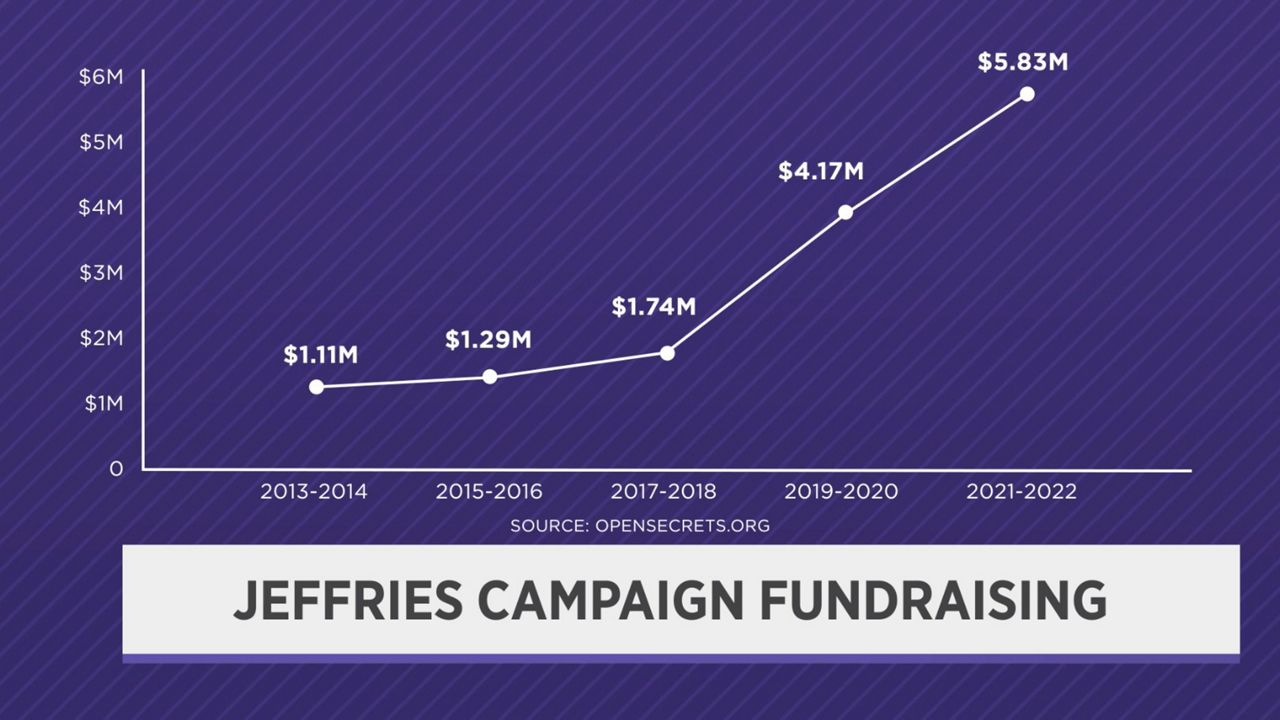In becoming House Democratic leader, Rep. Hakeem Jeffries is succeeding one of the party’s icons: former Speaker Nancy Pelosi.
Jeffries, who joined Congress when Pelosi was already halfway through her two decade stint as the top House Democrat, says Pelosi will “go down in history as the greatest speaker of all time.”
Now, as he takes on the reins, some who know Jeffries expect the Brooklyn congressman to handle the job a bit differently than his long-tenured predecessor.
What You Need To Know
- Rep. Hakeem Jeffries' former chief of staff says he expects the Brooklyn Democrat's leadership style will be "more bottom up and more inclusive" compared to Nancy Pelosi
- Jeffries was the unanimous choice of House Democrats to lead them. But whether the caucus can stay unified in the long term is not yet clear — especially if they will back the majority in 2024
- Some on the left are skeptical of Jeffries, criticizing him for not signing onto the Green New Deal resolution and for helping create a PAC to defend incumbent Democrats
- If he becomes Speaker, Jeffries would make history as the first person of color to hold the role. When asked if pursuing the White House is something he would entertain, Jeffries said, “No”
“Her leadership style was more top down and I think Hakeem’s will be more bottom up and more inclusive. Consensus building, very deliberative, but yet decisive,” said Cedric Grant, who served as Jeffries’ first chief of staff.
Former Congressman Tom Reed, a New York Republican who worked with Jeffries on legislation, agrees.
“I definitely think he will not be as top-down heavy. I think he’s going to seek out input,” he said. “I think he’s going to surround himself with members that he trusts, that kind of dissipates some of the power.”
Jeffries has already hinted at a collaborative approach.
In his November letter announcing his candidacy for Democratic leader, he promised to “empower” members of the caucus, ensuring everyone has an “authentic seat at the legislative table.
”In an interview with NY1 in early January, Jeffries expanded on how he plans to lead, saying that as the party goes through a moment of transition, “it will necessarily require a team effort across the House Democratic Caucus, beyond the leadership individuals, in order to be able to take the baton.”
Unifying a diverse caucus
Jeffries was the unanimous choice of House Democrats to lead them. But whether the caucus can stay unified in the long term is not yet clear.
If Democrats win back the majority in two years, they will have the power to determine the House agenda and there will likely be competing pressures from within the ranks to shape it — including from the coalition’s left flank, with which Jeffries has at times had a complex relationship.
Asked in November if Jeffries is progressive enough to appease the so-called Squad and the progressive end of the party, Rep. Jamaal Bowman said “there’s going to be some fights, and some conversations.”
“But that’s what’s supposed to happen, right? That’s the point of democracy. That’s the point of the Democratic Party,” he continued.
Bowman, who represents parts of the Bronx and Westchester County, is a member of the Squad and is backed by the progressive organization Justice Democrats.
He also is excitedly embracing his fellow New Yorker’s new job.
“I’ve had many conversations with Hakeem around racial justice. We’re on the same page there. On economic justice — we’re on the same page. Universal child care — we’re on the same page,” Bowman said.
But others on the left are far more skeptical.
Climate activists in the progressive Sunrise Movement have condemned Jeffries for not joining other New York City congressional Democrats in signing on to the Green New Deal resolution.
They question how highly he prioritizes the climate fight, though the League of Conservation Voters gave Jeffries a lifetime score of 96% on their most recent National Environmental Scorecard.
Some have criticized him for helping to launch a political action committee (PAC) to support incumbents in primaries, seeing it as a swipe against progressive challengers.
“I think that it would be beneficial for him to spend more time focusing on fighting Republicans than fighting those in his own party,” said Tyler Hack with the Sunrise Movement NYC.
Jeffries has not shied away from pushing back, telling The Atlantic in 2021 that there “will never be a moment where I bend the knee to hard-left democratic socialism.”
However, Jeffries says it is not correct to say he has “gone after the left flank of the party.”
“When called upon to respond, I will at times not hesitate in responding. But it never is gratuitous in the first instance,” he said. “But, if I’m asked to respond, sometimes I’ll respond. And I’ll respond in a way consistent with my upbringing.”
Reed says that when ideological differences among Democrats emerge, Jeffries may have to rule with a heavier hand to force consensus — especially if margins in the House are tight.
“I think he’s going to maybe have to pivot back a little bit more to that ‘top down’ type of leadership,” Reed said. “But, you know, time will tell.”
Fundraising
As he has risen through the ranks, Jeffries’ fundraising prowess has grown.
As a House backbencher with token opposition, he regularly raised less than $2 million each campaign, according to data compiled by campaign finance watchdog OpenSecrets.org.
That total more than doubled after he took on the role of Democratic Caucus Chair. In the last campaign cycle, Jeffries raised nearly $6 million.

That total still pales compared to Pelosi, who raised nearly $25 million in the 2022 cycle.
Now that Jeffries is in the top job, OpenSecrets.org research director Sarah Bryner says Jeffries’ fundraising is likely to rise.
“I expect that in 2024, we’ll see all the chickens come home to roost,” she said, arguing his fundraising should begin to line up “with all of the people who have traditionally held these roles.”
Speaker? President? What’s next?
In the near future, one of Jeffries’ main goals as Democratic leader is winning back control of the House in 2024. Democrats only need to flip a handful of seats, with many potential pickup opportunities back home in New York.
If successful, Jeffries would be poised to become House Speaker. But what about the presidency?
At least one close Jeffries ally, Rep. Gregory Meeks of Queens, floated the possibility.
“I want him to be the Speaker for as long as he wants to be,” Meeks said. “But if he decides he needs to go to 1600 Pennsylvania Avenue at some point, I don’t think that there is any ceiling on Hakeem Jeffries.”
Meeks calls Jeffries a “unique” talent, “just as Barack Obama was a unique talent.” But, Meeks said, he thinks Jeffries should be the Speaker.
When asked if pursuing the White House is something he would entertain, Jeffries said, “No.”
“My focus right now is doing the best job that I can in the position that I hold, making sure that we deliver results for the American people, implement our successful legislative agenda that comes out of the last Congress, work closely with President Biden, make sure he’s re-elected and do everything we can to win back control of the House of Representatives in 2024,” Jeffries continued.
Is that taking it off the table entirely? “Yes,” Jeffries replied.
Leading the House of Representatives one day, though, is very much on the table.
Only 55 people have served as Speaker since 1789.
Jeffries would be the first person of color and first person representing a district in New York City to become Speaker, cementing a remarkable climb to power for a son of Brooklyn who won his first election just 16 years ago.
This story is the final part of a four-part series, tracking Jeffries’ path to power. The first story on Jeffries’ Brooklyn roots can be found here. The second part on Jeffries' path from electoral losses to becoming the top House Democrat can be found here. The third part on Jefferies' push to reform the criminal justice system can be found here.








_Dnt_AI_)
